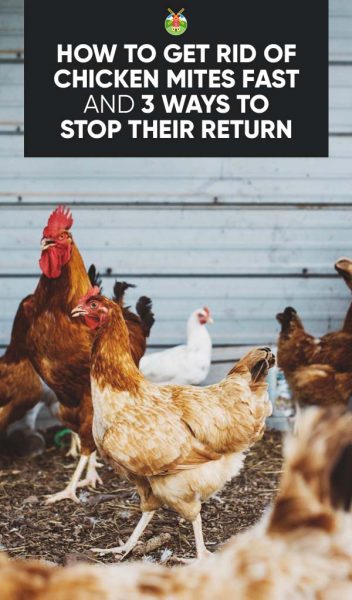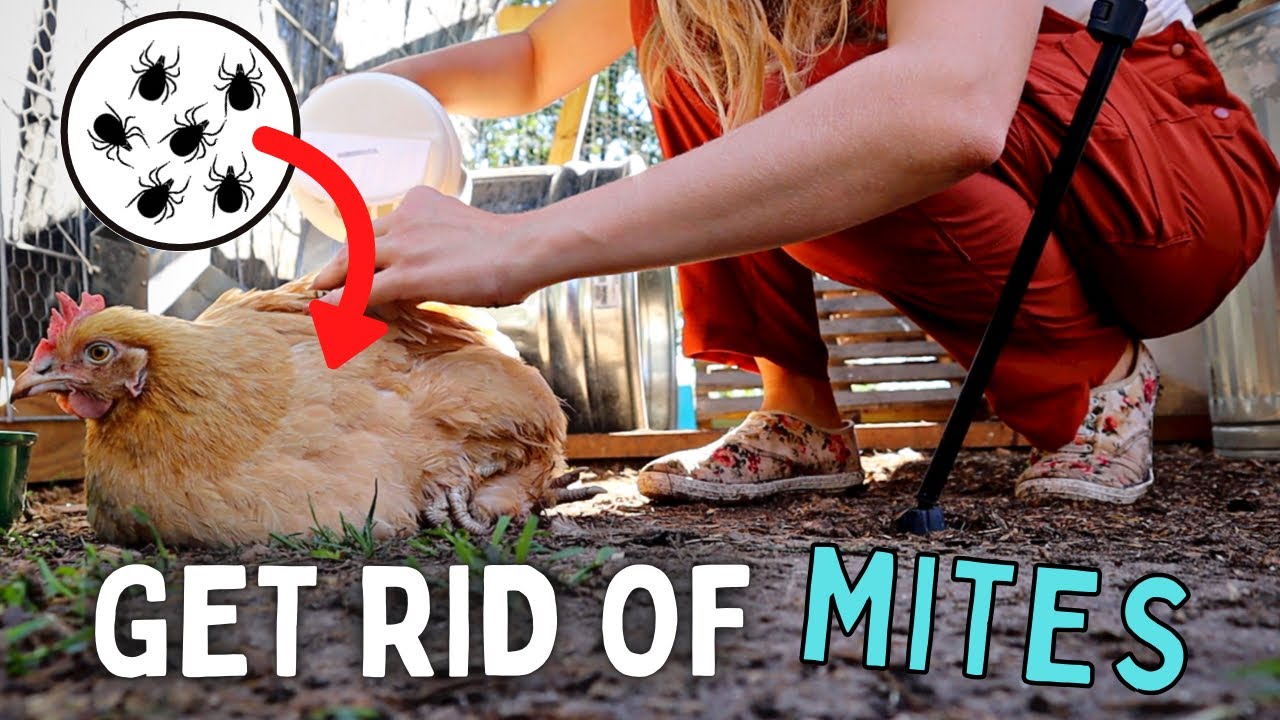Poultry mites are tiny pests that can cause big problems. They make chickens uncomfortable and can affect their health.
Getting rid of poultry mites requires knowledge and effort. These mites can cause itching, irritation, and even reduce egg production. Your chickens deserve a safe, mite-free environment to thrive. This blog will guide you through effective methods to eliminate poultry mites.
We’ll cover simple steps and tips to ensure your flock stays healthy and happy. By the end, you’ll know how to protect your chickens from these pesky intruders. Let’s dive in and learn how to make your poultry coop mite-free.

Credit: www.youtube.com
Identifying Poultry Mites
Poultry mites are small, parasitic insects that infest birds, causing irritation and discomfort. To get rid of these pests, clean the coop thoroughly, treat the birds with mite sprays, and maintain regular hygiene. Effective management reduces mite infestations and keeps your flock healthy.
Poultry mites can cause major problems for your flock. These tiny parasites feed on the blood of birds, leading to discomfort and health issues. To protect your poultry, it is essential to identify these mites early.Common Signs
One of the first signs of poultry mites is restless birds. Your chickens may scratch more than usual. You might notice them preening their feathers excessively. Feather loss can also occur. Look for small red or black spots on the skin. These are mites or their droppings. Check the birds’ legs and around their vents. Mites often hide in these areas.Types Of Poultry Mites
There are several types of poultry mites. The most common include the red mite, the northern fowl mite, and the scaly leg mite. Red mites hide during the day and feed at night. You can find them in the coop’s cracks and crevices. Northern fowl mites live on the bird at all times. They can cause severe irritation and anemia. Scaly leg mites burrow under the scales on a bird’s legs. This causes swelling and deformities. Identifying these pests quickly can help you take action. Keep your poultry healthy and comfortable. “`
Credit: morningchores.com
Health Risks Posed By Mites
Poultry mites are tiny but dangerous pests. They can cause serious health issues for both chickens and humans. Understanding these risks is crucial. It helps in taking effective measures to protect your flock and yourself.
Impact On Chickens
Mites can cause severe discomfort in chickens. They bite and suck blood, leading to anemia. Chickens may become weak and lethargic. Their egg production can drop dramatically. Constant itching and irritation can stress them out. This makes them more susceptible to diseases.
Potential Human Risks
Mites can also affect humans. They might bite you, causing skin irritation and itching. Some people may develop allergic reactions. These reactions can include rashes or respiratory issues. Mites can also infest your home. They can hide in bedding, carpets, and furniture. This makes it essential to act quickly to eliminate them.
Preventive Measures
Preventive measures are crucial to keep poultry mites at bay. By implementing a few simple practices, you can ensure a healthy environment for your birds and reduce the risk of infestation. Here, we will discuss two key preventive measures: Regular Cleaning and Proper Ventilation.
Regular Cleaning
Regular cleaning of the coop is essential. It minimizes the chances of mites spreading and breeding. Follow these steps for effective cleaning:
- Remove all bedding and nesting materials.
- Wash the coop with hot, soapy water.
- Disinfect the entire area using a poultry-safe disinfectant.
- Allow the coop to dry completely before adding fresh bedding.
Clean the coop at least once a week. Pay special attention to corners and crevices where mites often hide. Regular cleaning keeps the environment healthy for your poultry.
Proper Ventilation
Proper ventilation is another vital preventive measure. It helps maintain a dry and comfortable environment for your birds. Good ventilation can be achieved by:
- Installing vents or windows to allow fresh air in.
- Ensuring there is no moisture buildup inside the coop.
- Using fans or exhaust systems if necessary.
A well-ventilated coop reduces humidity levels, making it less attractive for mites. This simple step goes a long way in keeping your poultry mite-free.
By focusing on regular cleaning and proper ventilation, you can create a healthier living space for your birds. These measures are easy to implement and highly effective in preventing mite infestations.
Natural Remedies
Dealing with poultry mites can be a daunting task. These tiny pests can cause discomfort and health issues for your birds. Fortunately, there are natural remedies that can help you get rid of them effectively. Using natural solutions is not only safe for your birds but also environmentally friendly. In this section, we will explore some of the best natural remedies to combat poultry mites.
Essential Oils
Essential oils are powerful and effective against poultry mites. Here are some common essential oils that can help:
- Tea Tree Oil: Known for its anti-parasitic properties. Dilute and spray on infested areas.
- Lavender Oil: Helps to repel mites. Mix with water and apply to the coop.
- Eucalyptus Oil: Effective in killing mites. Add a few drops to a spray bottle with water.
Always dilute essential oils before use. Ensure proper ventilation in the coop during application. Repeat treatment weekly for best results.
Herbal Solutions
Herbs can naturally help in repelling and killing poultry mites. Some effective herbs include:
- Garlic: Crushed garlic mixed with water can be sprayed on infested areas.
- Mint: Plant mint around the coop or use mint leaves inside.
- Neem: Neem leaves or oil can be used as a spray to kill mites.
Herbal solutions are safe and non-toxic. Regular use can prevent mite infestations. Keep herbs fresh for maximum effectiveness.
Combining these natural remedies can provide a comprehensive approach to controlling poultry mites. Your birds will thank you for it!
Chemical Treatments
Chemical treatments can effectively get rid of poultry mites. These treatments come in different forms, such as insecticidal sprays and dusting powders. Each method has its own benefits and application techniques. Here is a closer look at both options.
Insecticidal Sprays
Insecticidal sprays are a common choice for treating poultry mites. These sprays are easy to apply and can cover large areas quickly. Here are some steps to use insecticidal sprays:
- Choose a spray labeled for poultry use.
- Read the instructions carefully before application.
- Wear protective clothing, such as gloves and a mask.
- Spray the coop, focusing on cracks and crevices.
- Repeat the treatment as directed on the label.
Important: Ensure the chickens are removed from the coop during treatment. Allow the coop to air out before returning the birds.
Dusting Powders
Dusting powders are another effective option for controlling poultry mites. These powders can be applied directly to the birds and their environment. Follow these steps to use dusting powders:
- Select a dusting powder safe for poultry.
- Gently dust the powder onto the birds, focusing on the neck, under the wings, and around the vent.
- Apply the powder to the coop, especially in nesting boxes and perches.
- Reapply as needed, according to the product’s instructions.
Tip: Use a duster or an old sock filled with powder for easier application.
Both insecticidal sprays and dusting powders can help manage poultry mites. Choose the method that works best for you and your flock. Regular treatment and good coop hygiene are key to keeping mites at bay.
Maintaining A Mite-free Environment
Keeping your poultry farm free from mites is essential. Mites can harm your birds and reduce their productivity. A clean, well-maintained environment helps prevent mite infestations.
Routine Inspections
Regularly check your poultry for mites. Inspect feathers, skin, and nests. Look for small red or black dots, which are mites. Early detection is key to controlling mites.
- Inspect birds weekly
- Check under wings and around vents
- Examine nesting boxes and perches
Sanitizing Equipment
Clean all equipment thoroughly. Mites can hide in cracks and crevices. Use hot water and disinfectants to sanitize feeders, waterers, and cages.
| Equipment | Cleaning Frequency | Sanitizing Method |
|---|---|---|
| Feeders | Weekly | Hot water and soap |
| Waterers | Weekly | Disinfectant solution |
| Cages | Monthly | Pressure wash and disinfect |
Dispose of old bedding properly. Change bedding regularly. Clean the coop and nesting areas often. This reduces mite habitats.
- Remove old bedding
- Wash coop with disinfectant
- Replace with fresh bedding
Maintain a dry environment. Mites thrive in moist areas. Ensure proper ventilation and drainage in your coop.
Treating Infested Birds
Poultry mites can cause severe discomfort to your birds. They feed on blood, leading to stress and health issues. Treating infested birds is essential for their well-being. There are several methods to treat mites effectively. Below are detailed solutions to help you manage this issue.
Bathing Solutions
One effective way to treat mites is through bathing. You can use a simple bath solution. Here are some suggested ingredients:
- Warm water
- Mild dish soap
- Apple cider vinegar
Mix warm water with a few drops of mild dish soap. Add a splash of apple cider vinegar. The vinegar helps in repelling mites. Gently bathe your birds in this mixture. Ensure the solution reaches their skin. Rinse thoroughly with clean water. Dry the birds completely to avoid chills.
Topical Treatments
Topical treatments are another effective method. These are products applied directly to the bird’s skin. Here are some commonly used options:
| Product | Description | Application |
|---|---|---|
| Neem Oil | Natural oil with antiparasitic properties | Apply a few drops directly on affected areas |
| Pyrethrin Spray | Derived from chrysanthemum flowers | Spray lightly over the bird’s body, avoiding the eyes |
| Diatomaceous Earth | Fine powder that dehydrates mites | Dust lightly over feathers and skin |
Always follow the instructions on the product label. Overuse can harm your birds. Monitor your birds closely after treatment. Look for any signs of irritation or allergic reactions.
Long-term Management
Long-term management of poultry mites requires consistent and proactive measures. By implementing these strategies, you can keep your flock healthy and comfortable. This section will discuss two effective long-term management techniques: rotating pastures and regular monitoring.
Rotating Pastures
Rotating pastures is essential to control poultry mites. Move your flock to different areas regularly. This breaks the lifecycle of mites. Mites do not thrive without a host for long. By rotating pastures, you reduce their population.
Ensure each pasture is empty for a few weeks. This allows any remaining mites to die off. Clean and treat empty pastures to remove any lingering mites. This practice also benefits the grass and soil, promoting a healthier environment.
Regular Monitoring
Regular monitoring is crucial for long-term mite management. Check your birds and coops frequently. Look for signs of mites like itching, feather loss, and red spots on the skin. Early detection helps prevent infestations from spreading.
Inspect nesting boxes, perches, and other areas where mites may hide. Use a flashlight to see better in dark corners. Keep records of your findings to track any changes over time. Regular monitoring ensures you stay ahead of any potential issues.

Credit: www.wikihow.com
Frequently Asked Questions
What Are Poultry Mites?
Poultry mites are tiny parasites that feed on the blood of birds. They can cause discomfort, irritation, and anemia in chickens.
How Do I Identify Poultry Mites?
Look for signs like itching, redness, and feather loss in your chickens. You may also see tiny, crawling mites on their skin.
What Are Natural Treatments For Poultry Mites?
Natural treatments include diatomaceous earth, garlic, and essential oils. These can help eliminate mites without harmful chemicals.
How Often Should I Clean The Coop?
Clean the coop at least once a week. Regular cleaning helps prevent mite infestations and keeps your chickens healthy.
Conclusion
To sum up, getting rid of poultry mites takes effort and care. Regular cleaning helps. Use safe treatments to protect your birds. Check often for mites to catch them early. Healthy birds are happy birds. Follow these steps, and your poultry will thrive.
Remember, patience and consistency are key. Keep learning and adapting. Your birds depend on you.




